-
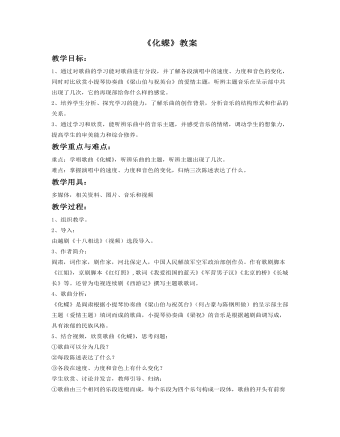
《化蝶》教案
教学过程:1、组织教学。2、导入:由越剧《十八相送》(视频)选段导入。3、作者简介:阎肃,词作家,剧作家,河北保定人,中国人民解放军空军政治部创作员。作有歌剧脚本《江姐》,京剧脚本《红灯照》,歌词《我爱祖国的蓝天》《军营男子汉》《北京的桥》《长城长》等。还曾为电视连续剧《西游记》撰写主题歌歌词。4、歌曲分析:《化蝶》是阎肃根据小提琴协奏曲《梁山伯与祝英台》(何占豪与陈钢所做)的呈示部主部主题(爱情主题)填词而成的歌曲,小提琴协奏曲《梁祝》的音乐是根据越剧曲调写成,具有浓郁的民族风格。5、结合视频,欣赏歌曲《化蝶》,思考问题:①歌曲可以分为几段?②每段陈述表达了什么?③各段在速度、力度和音色上有什么变化?学生欣赏、讨论并发言,教师引导、归纳:①歌曲由三个相同的乐段连缀而成,每个乐段为四个乐句构成一段体,歌曲的开头有前奏(引子),中间有间奏(经过句),实际上相当于一个乐段的三次反复
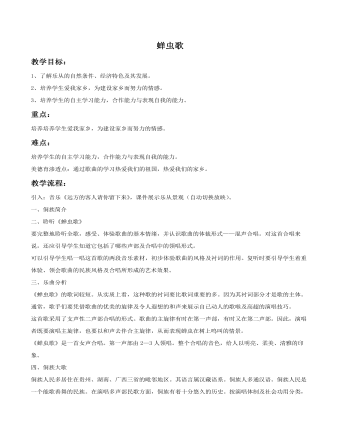
《蝉虫歌》教案
教学流程:引入:音乐《远方的客人请你留下来》,课件展示乐从景观(自动切换放映)。一、侗族简介二、聆听《蝉虫歌》要完整地聆听全歌,感受、体验歌曲的基本情绪,并认识歌曲的体裁形式——混声合唱。对这首合唱来说,还应引导学生知道它包括了哪些声部及合唱中的领唱形式。可以引导学生唱一唱这首歌的两段音乐素材,初步体验歌曲的风格及衬词的作用。复听时要引导学生着重体验、领会歌曲的民族风格及合唱所形成的艺术效果。三、乐曲分析《蝉虫歌》的歌词较短。从实质上看,这种歌的衬词要比歌词重要的多。因为其衬词部分才是歌的主体。通常,歌手们要凭借歌曲的优美的旋律及令人遐想的和声来展示自已动人的歌喉及高超的演唱技巧。这首歌采用了支声性二声部合唱的形式。歌曲的主旋律有时在第一声部,有时又在第二声部。因此,演唱者既要演唱主旋律,也要以和声去伴合主旋律,从而表现蝉虫在树上鸣叫的情景。《蝉虫歌》是一首女声合唱。第一声部由2—3人领唱。整个合唱的音色,给人以明亮、柔美、清雅的印象。
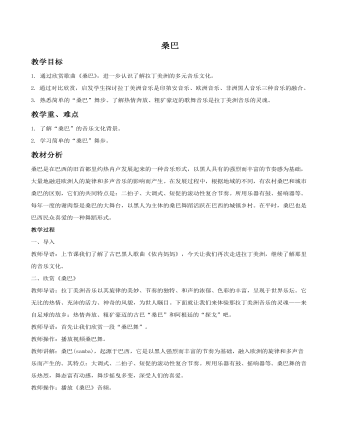
《桑巴》教案
教学过程一、导入教师导语:上节课我们了解了古巴黑人歌曲《依内妈妈》,今天让我们再次走进拉丁美洲,继续了解那里的音乐文化。二、欣赏《桑巴》教师导语:拉丁美洲音乐以其旋律的美妙、节奏的独特、和声的浓郁、色彩的丰富,呈现于世界乐坛。它无比的热情、充沛的活力、神奇的风貌,为世人瞩目。下面就让我们来体验那拉丁美洲音乐的灵魂——来自足球的故乡:热情奔放、粗犷豪迈的古巴“桑巴”和阿根廷的“探戈”吧。教师导语:首先让我们欣赏一段“桑巴舞”。教师操作:播放视频桑巴舞。教师讲解:桑巴(samba),起源于巴西,它是以黑人强烈而丰富的节奏为基础,融入欧洲的旋律和多声音乐而产生的。其特点:大调式、二拍子、短促的滚动性复合节奏。所用乐器有鼓、摇响器等。桑巴舞的音乐热烈,舞态富有动感,舞步摇曳多变,深受人们的喜爱。 教师操作:播放《桑巴》音频。教师导语:让我们大家一起随着音乐跳起来吧!学生活动:边听音乐边拍打节奏,学做简单的“桑巴”舞蹈动作,并随音乐跳舞。三、课堂小结本节课通过欣赏乐曲《桑巴》,同学们进一步的了解认识了拉丁美洲的多元音乐文化。又通过对比欣赏,启发学生探讨了拉丁美洲音乐是印第安音乐、欧洲音乐、非洲黑人音乐三种音乐的融合。
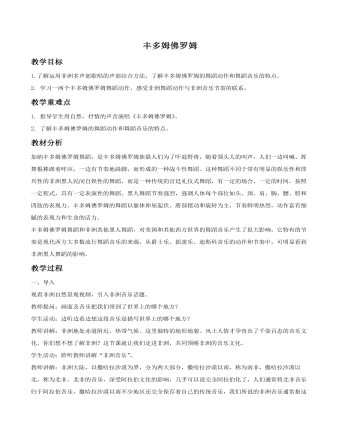
《丰多姆佛罗姆》教案
教学过程一、导入观看非洲自然景观视频,引入非洲音乐话题。教师提问:画面及音乐把我们带到了世界上的哪个地方?学生活动:边听边看边想这段音乐是描写世界上的哪个地方?教师讲解:非洲地处赤道附近,热带气候。这里独特的地形地貌、风土人情才孕育出了千姿百态的音乐文化。你们想不想了解非洲?这节课就让我们走进非洲,共同领略非洲的音乐文化。学生活动:聆听教师讲解“非洲音乐”。教师讲解:非洲大陆,以撒哈拉沙漠为界,分为两大部分,撒哈拉沙漠以南,称为南非,撒哈拉沙漠以北,称为北非。北非的音乐,深受阿拉伯文化的影响,几乎可以说完全阿拉伯化了,人们通常将北非音乐归于阿拉伯音乐,撒哈拉沙漠以南不少地区还完全保存着自己的传统音乐,我们所说的非洲音乐通常指这些地区各种土著黑人的传统音乐。二、学唱歌曲《丰多姆佛罗姆》1.教师播放歌曲《丰多姆佛罗姆》,提问:这首歌曲的情绪如何?表达了怎样的思想感情?学生活动:完整地欣赏,思考乐曲的情绪和表达的思想感情。(抒情性的音乐情绪,表达对家乡的思念之情。)2.介绍作品。教师讲解:这是一首典型的非洲民歌。歌曲以生动的语言叙述了黑人战斗的情境。
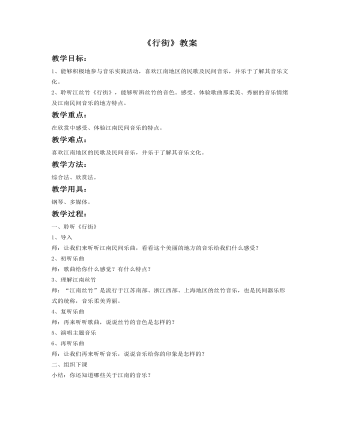
《行街》教案
教学过程:一、聆听《行街》1、导入师:让我们来听听江南民间乐曲,看看这个美丽的地方的音乐给我们什么感受?2、初听乐曲师:歌曲给你什么感觉?有什么特点?3、理解江南丝竹师:“江南丝竹”是流行于江苏南部、浙江西部、上海地区的丝竹音乐,也是民间器乐形式的统称,音乐柔美秀丽。4、复听乐曲师:再来听听歌曲,说说丝竹的音色是怎样的?5、演唱主题音乐6、再听乐曲师:让我们再来听听音乐,说说音乐给你的印象是怎样的?二、组织下课小结:你还知道哪些关于江南的音乐?
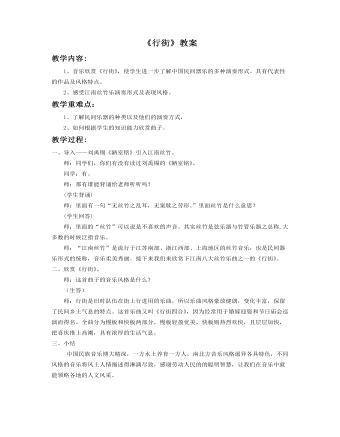
《行街》教案
教学过程:一、导入——刘禹锡《陋室铭》引入江南丝竹。 师:同学们,你们有没有读过刘禹锡的《陋室铭》。 同学:有。 师:那有谁能背诵给老师听听吗? (学生背诵) 师:里面有一句“无丝竹之乱耳,无案牍之劳形。”里面丝竹是什么意思? (学生回答) 师:里面的“丝竹”可以说是不喜欢的声音。其实丝竹是弦乐器与竹管乐器之总称,大多数的时候泛指音乐。 师:“江南丝竹”是流行于江苏南部、浙江西部、上海地区的丝竹音乐,也是民间器乐形式的统称,音乐柔美秀丽。接下来我们来欣赏下江南八大丝竹乐曲之一的《行街》。二、欣赏《行街》。 师:这首曲子的音乐风格是什么? (生答) 师:行街是旧时队伍在街上行进用的乐曲,所以乐曲风格豪放健朗,变化丰富,保留了民间乡土气息的特点。这首乐曲又叫《行街四合》,因为经常用于婚嫁迎娶和节日庙会巡演而得名。全曲分为慢板和快板两部分,慢板轻盈优美,快板则热烈欢快,且层层加快,把喜庆推上高潮,具有浓厚的生活气息。三、小结 中国民族音乐博大精深,一方水土养育一方人,南北方音乐风格迥异各具特色,不同风格的音乐将风土人情描述得淋漓尽致,感谢劳动人民的的聪明智慧,让我们在音乐中就能领略各地的人文风采。
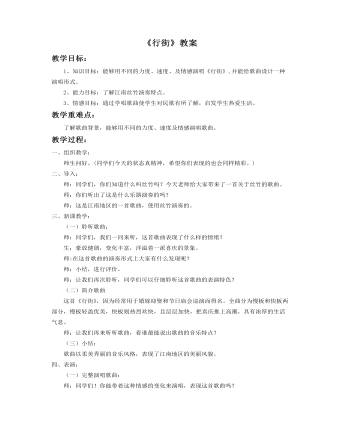
《行街》教案
教学过程:一、组织教学:师生问好。(同学们今天的状态真精神,希望你们表现的也会同样精彩。)二、导入:师:同学们,你们知道什么叫丝竹吗?今天老师给大家带来了一首关于丝竹的歌曲。师:你们听出了这是什么乐器演奏的吗? 师:这是江南地区的一首歌曲,使用丝竹演奏的。 三、新课教学: (一)聆听歌曲: 师:同学们,我们一同来听,这首歌曲表现了什么样的情绪? 生:豪放健朗,变化丰富,洋溢着一派喜庆的景象。师:在这首歌曲的演奏形式上大家有什么发现呢? 师:小结,进行评价。 师:让我们再次聆听,同学们可以仔细聆听这首歌曲的表演特色?(二)简介歌曲这首《行街》,因为经常用于婚嫁迎娶和节日庙会巡演而得名。全曲分为慢板和快板两部分,慢板轻盈优美,快板则热烈欢快,且层层加快,把喜庆推上高潮,具有浓厚的生活气息。 师:让我们再来听听歌曲,看谁最能说出歌曲的音乐特点? (三)小结: 歌曲以柔美秀丽的音乐风格,表现了江南地区的美丽风貌。四、表演: (一)完整演唱歌曲: 师:同学们!你能带着这种情感的变化来演唱,表现这首歌曲吗?
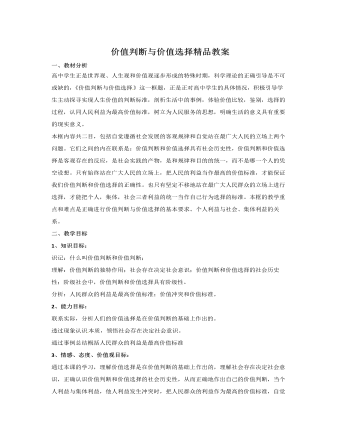
人教版高中政治必修4价值判断与价值选择精品教案
南极大地的水陆交接处,全是滑溜溜的冰层或者尖锐的冰棱。企鹅没有可以用来攀爬的前臂,也没有可以飞翔的翅膀,如何从水中上岸?纪录片《深蓝》展示,企鹅在将要上岸之时,要从海面潜入海中,沉潜到适当的深度,借用水的浮力,迅猛向上,飞出一道弧线,落于陆地之上。企鹅的沉潜是为了蓄势,看似笨拙,却富有成效。人生又何尝不是如此?沉潜绝非沉沦,而是勇敢、智慧、自强。如果我们在困难面前能沉下气来,不被“冰棱”吓倒,不被浮华迷惑,专心致志,自强不息,积聚力量,并抓住恰当的机会反弹向上,毫无疑问,我们就能成功登陆!反之,总是随波浮沉,或者怨天尤人,注定就会被命运的风浪所玩弄,直至精疲力竭。结合上述材料,运用《生活与哲学》知识对“价值观是人生的重要向导,有价值观的人生才是更美的人生”加以评析。7、有两名畜牧兽医专业毕业的大学生应聘到农村养猪场担任技术总监后,大力推广使用生态养猪法和中草药防疫技术,使养猪场步入了良性发展轨道。
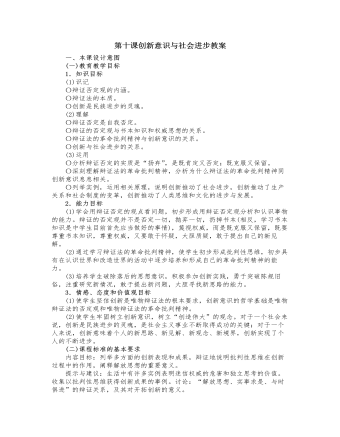
人教版高中政治必修4第十课创新意识与社会进步教案
2.辩证的否定(1)辩证的否定是事物的自我否定。事物内部存在着肯定方面和否定方面,它们既对立又统一。最初,肯定方面处于支配地位,否定方面处于被支配地位。在这种情况下,事物就被肯定着。但是,在矛盾双方的斗争中,否定方面总会由弱变强。一旦否定方面由被支配地位上升为支配地位,事物就转化到了自己的对立面,实现了对事物的否定。事物最终之所以被否定,根源在于事物的内部,是事物内部的否定因素战胜了肯定因素。因此,事物的否定是自我否定。(2)辩证的否定是事物发展的环节和联系的环节。所谓发展,是指新事物的产生和旧事物的灭亡。而实现这一过程必须要对旧事物进行否定,否定实现了事物由旧质向新质的飞跃。新事物在否定旧事物时,并不是把旧事物全盘抛弃,一笔勾销。旧事物是新事物的母体,新事物从旧事物那里脱胎而来,新事物是在批判地继承旧事物中的一切积极的有生命力的因素的基础上发展起来的。这样,在新旧事物之间就存在着必然的联系。
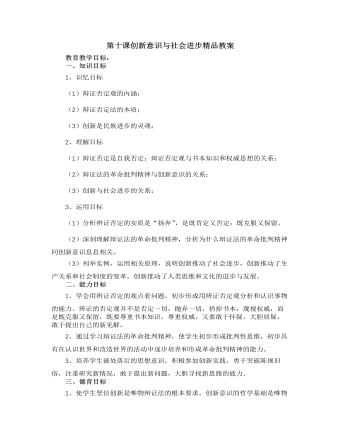
人教版高中政治必修4第十课创新意识与社会进步精品教案
在数学上,0这个数是解决记数和进位问题而引进的概念,由于它不能表示实在的东西,很长时间人们不把它看作是一个数。认为0是无,是对有的否定。从唯物辩证法的观点看,这种否定不是形而上学的简单否定,而是具有丰富内容的辨证否定。辨证的否定是发展的环节。0是从无到有的必经之路,是连接无和有的桥梁。0又是正数和负数之间的界限,它既否定了任何正数,也否定了任何负数,是唯一的中性数。但它又是联结正数和负数的中间环节。没有0,负数就过渡不到正数去,正数也休想发展到负数来。数学中的0是对任何定量的否定。如果没有这一否定,任何量的发展都无从谈起。这个否定不是一笔勾销,而是扬弃。因为它克服了任何定量的有限性,成为其发展的环节。在现实生活中,0作为辨证的否定,也体现出联系和发展的性质。如0度不是没有温度,而是非常确定的温度。
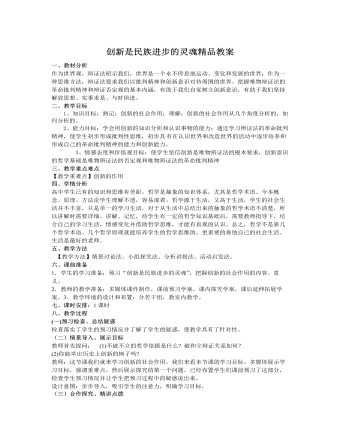
人教版高中政治必修4创新是民族进步的灵魂精品教案
一、教材分析作为世界观,辩证法昭示我们,世界是一个永不停息地运动、变化和发展的世界;作为一种思维方法,辩证法要求我们以批判精神和创新意识对待周围的世界。把握唯物辩证法的革命批判精神和辩证否定观的基本内涵,有助于我们自觉树立创新意识,有助于我们坚持解放思想、实事求是、与时俱进。二、教学目标1、知识目标:熟记:创新的社会作用;理解:创新的社会作用从几个角度分析的,如何分析的。2、能力目标:学会用创新的知识分析和认识事物的能力;通过学习辨证法的革命批判精神,使学生初步形成批判性思维,初步具 有在认识世界和改造世界的活动中逐步培养和形成自己的革命批判精神的能力和创新能力。3、情感态度和价值观目标:使学生坚信创新是唯物辨证法的根本要求,创新意识的哲学基础是唯物辨证法的否定观和唯物辨证法的革命批判精神

人教版新课标高中地理必修2第三章第一节农业区位的选择教案
1.澳大利亚混合农业地域在生产结构、经营方式、科技应用、农业专业化和地域化等方面有哪些特点?2.在澳大利亚混合农业地 域形成的过程中,有哪些区位因素在起作用?学生发言,教师适当引导、评点并作讲解。[教师提问]:那么,澳大利亚的墨累—达令盆地的区位因素有什么不足之处?知识拓展:课件展示澳大利亚大分水岭的雨影效应的形成原理及东水西调示意图。[教师讲解]:澳大利亚东南部受大分水岭的影响,降水集中于大分水岭的东侧,在其西侧形成山地的雨影效应,降水丰富地区与农业生产地区分布不一致,灌溉成为澳大利亚农牧业发展的限制性条件。因此,澳大利亚对水利工程建设很 重视,东水西调促进了墨累—达令盆地农牧业的发展。[课堂小结]:这节课我们学习了农业区位选择的基本原理。 通过学习我们了解到,农业的区位选择实质上就是对农业土地的合理利用。

人教版高中政治必修3在文化生活中选择教案2篇
(二)“奥运福娃”探究1、“五福娃”体现了哪些精神?体现了“科技奥运、人文奥运和绿色奥运”的奥运精神也体现了“团结、奋进、爱好和平”的民族精神。2、“龙”是中华民族的图腾,我们自称是龙的传人,但北京奥运吉祥物里为什么没有“龙”?“龙”(dragon)在我国是美好的意思,例如龙凤呈祥,但在西方是魔鬼,很恐怖。北京奥运不仅是中国的奥运,更是世界的奥运,因此,福娃的原形中没有龙,这就是文化选择的结果。(三)感受先进文化1、交流自己最喜爱的文化。2、观看《千手观音》,谈观后感。(四)阳光下有阴影1、小品《电脑算命》2、课堂辩论正方:“烧香敬神”是封建迷信活动,不可取反方:“烧香敬神”是精神信仰活动,可取3、提高眼力,拒绝污染了解现实生活中的落后文化、腐朽文化,自觉抵制社会中落后文化、腐朽文化的毒害。
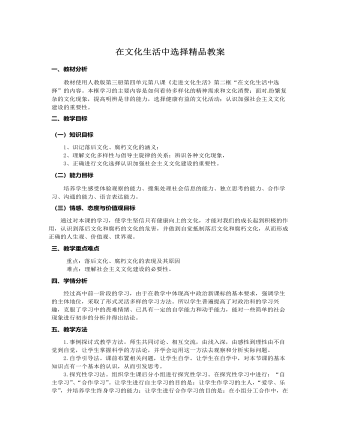
人教版高中政治必修3在文化生活中选择精品教案
一、教材分析教材使用人教版第三册第四单元第八课《走进文化生活》第二框“在文化生活中选择”的内容。本框学习的主要内容是如何看待多样化的精神需求和文化消费;面对 纷繁复杂的文化现象,提高明辨是非的能力,选择健康有益的文化活动;认识加强社会主义文化建设的重要性。二、教学目标(一)知识目标1、识记落后文化、腐朽文化的涵义;2、理解文化多样性与倡导主旋律的关系;辨识各种文化现象,3、正确进行文化选择认识加强社会主义文化建设的重要性。(二)能力目标培养学生感受体验观察的能力、搜集处理社会信息的能力、独立思考的能力、合作学习、沟通的能力、语言表达能力。(三)情感、态度与价值观目标通过对本课的学习,使学生坚信只有健康向上的文化,才能对我们的成长起到积极的作用,认识到落后文化和腐朽的文化的危害,并做到自觉抵制落后文化和腐朽文化,从而形成正确的人生观、价值观、世界观。

人教版新目标初中英语七年级上册Do you have a soccer ball教案
在这一单元中,学生要学会就有关人与物之间所属关系进行问答的句子。本单元大量引入有关运动的名词,要求学生彼此询问有无此类物品,并做出相应的回答。 同时学习表示建议的句型Let’s运动的形容词。 本单元所选用的话题来自学生所喜欢的生活片段,在教学中生生交流、师生交流会更融洽,会促进师生彼此间的了解,成功的教学还会让部分学生养成良好的运动习惯和收藏习惯。 教学目标 1) 语言知识:A.在询问对方是否有某物的对话中学会使用do和does引导的一般疑问句; B. 学会使用描述性的形容词来评价事物; C. 学会在对话中使用名词复数; D. 学会用祈使句来向对方提出建议. 2) 语言技能:A. 学会用祈使句询问某人是否有某物; B. 学会向他人提出建议的句子. 3) 学习策略:A.通过与同学讨论,做出猜测;

人教版新目标初中英语七年级上册Do you want to go to a movie教案
讨论喜欢的影视类型及理由:在看过一部影视作品后,大家总是喜欢在一起谈论影视的主要内容、主要情节、主要演员主题歌曲、主题音乐等,互相介绍自己对该影视的看法。教师可以组织一次活动,分组讨论学生喜欢看什么类型的电影,并说明喜欢的理由。运用I like…I don’t like…Because it is…等语言结构;然后每个组选派一名代表向全班学生阐述本组组员喜欢观看的电影类型;最后汇总,总结出全班同学最喜欢观看哪一种类型的电影。如果有可能,根据学生的选择放一部(一段)这种类型的影视节目。通过学生的讨论、调查,使他们在完成任务的过程中学会询问和陈述自己或别人在影视方面的喜好及理由,更好地巩固所学内容。Self Check教学内容Self Check(教材P58)教学目标知识与能力复习词汇go,movie,action,comedy,documentary,thriller,and,but,scary,funny, sad,exciting;引导学生复习、巩固“制订计划和打算并谈论喜好和偏爱”的目标语言。

人教版新目标初中英语八年级上册How do you make a banana milk shake教案2篇
1. First, ... then, ... next, ... finally, ...首先,……然后,……接着,……最后,……这是英语中表达做某事的步骤的一种说法。如果步骤较多,还可以说:first-next-after that-later on-finally/at last通常你会听到说英语国家的人在说 first, next, then, finally 和后面的内容时,他们会做一些停顿。这样就能提前告诉听者接下来讲的是一系列的步骤。这一点在朗读和听力中应特别注意。2. how many, how much均为疑问词,同是“多少”,但用法不同。请看:how many修饰可数名词复数,how much修饰不可数名词。但在用法上,同学们常犯如下错误:1) [误] How many are there bananas on the table?[正] How many bananas are there on the table?[析] how many, how much 中的many,much是形容词,常修饰名词作定语,故后面跟名词。2) [误]How much tea are there on the table?[正]How much tea is there on the table?[析] how much修饰不可数名词时,谓语动词用单数。how many与how much的区别可简记为:前how many:问“多少”,复数名词后面跑;how much问“多少”,不可数名词单数好。前者答语用基数词,后者答语用数量关系。

人教版新目标初中英语八年级上册Could you please clean your room教案3篇
一、 教学内容Section A 1a----1c二、 教学目标1.学习词汇do the dishes, make the bed, take out the trash, fold the clothes, do the laundry, sweep the floor, clean the living room.2.句型 Could you please clean your room? Yes, sure.三、 教学准备 学生预习本单元所有的词汇多媒体课件 活动表 奖品四、 教学过程Pre-task1. Warming upEnjoy ourselves. Watch cartoon Cinderella. 看动画片段《灰姑娘》导如入本课话题和新词汇“chores”美丽善良的鬼姑娘因继母的嫉妒,每天得做所有的家务。片段的主题使学生联想到本课的话题。2. learn new words and phrasesLook! What is she / he dong? 看图学习动词词组do chores, do the dishes, make the bed, take out the trash, fold the clothes, do the laundry, clean the living room.3. Guessing game.What is she doing ? 4. Pair work. 1a, Do you do these things at home? Write “Y” for “yes” and “N” for “no”.5. Listening . 1b , Peter’s chores or Mom’s chores?理解目标语Could you please clean your room? Yes, sure.Write “M” for Mom’s chores, “P” for Peter’s chores in the chart.6. PairworkLook at the picture,Ask your partner to do the chores that you see. 7. Interview Who is the most able at home? 1) What chores do you do at home? How often do you do the chores? Work in four, interview each of the students in the group, fill in the chart.

人教版新目标初中英语八年级上册I’m going to be a basketball player教案3篇
教学目标1.知识目标:(1)学习What are you going to be when you grow up?/How are you going to do that?句式。(2)学会用英语描述有关职业的表达法。2.能力目标:(1)能够谈论为实现理想所做出的打算和安排。(2)能够谈论未来自己与他人理想的职业及原因。(3)能用英语描述课余时间的活动安排,最终具备表达综合信息的能力。3.情感目标:新学期到来之际,让他们在学习、体育、饮食、特长、读书等方面制定计划,教育学生合理安排自己的课外生活,思考自己的理想职业及适合自己的职业。教学重点、难点本单元的重点为“be going to”表将来,want to be, what,where, when,how引导的特殊疑问句。难点是语言目标的实现。教材分析本单元以I am going to be a basketball player为话题,共设计了三部分的内容:一、Section A该部分有4个模块。第一模块围绕Do you think these jobs are interesting?这一话题展开思维(1a)、听力(1b)、口语(1c)训练;
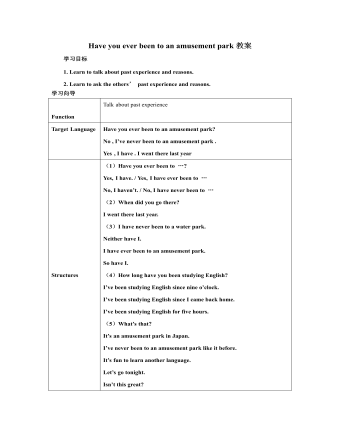
人教版新目标初中英语八年级下册Have you ever been to an amusement park教案
(1)Have you ever been to …? Yes, I have. / Yes, I have ever been to …No, I haven’t. / No, I have never been to …(2)When did you go there? I went there last year. (3)I have never been to a water park. Neither have I. I have ever been to an amusement park. So have I. (4)How long have you been studying English? I’ve been studying English since nine o’clock. I’ve been studying English since I came back home. I’ve been studying English for five hours. (5)What’s that? It’s an amusement park in Japan. I’ve never been to an amusement park like it before. It’s fun to learn another language. Let’s go tonight. Isn’t this great?space museum, amusement park, water park, South America, Peru, Holland, European culture, tour guide, flight attendant, musical instrument, more than, be from, get to, take lessons, neither, discover, graduate, change

